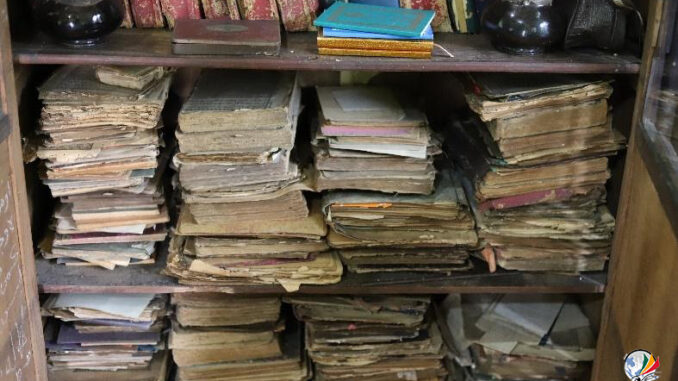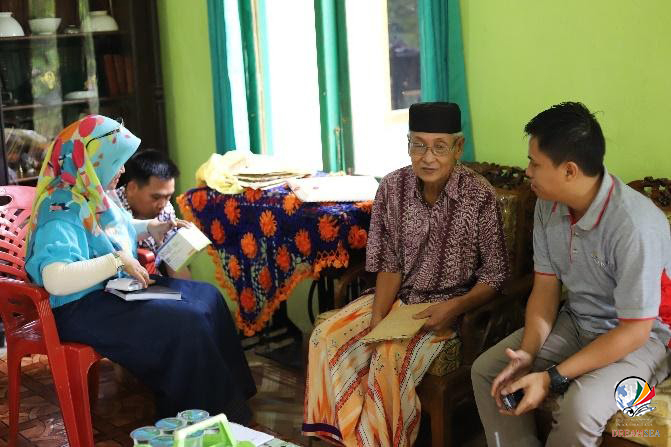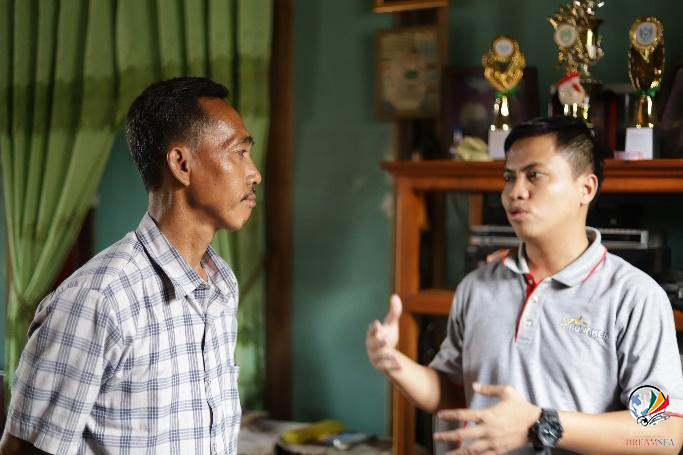
In August 2018, DREAMSEA organized its first field digitization mission of manuscript in Ogan Komering Ilir in South Sumatra. The DREAMSEA team consisted of four-persons, Nyimas Umi Kalsum who acted as academic expert, Muhammad Daud as assistant academic expert, Tedi Permadi as photographer, and Surya Selfika as assistant photographer. The mission was a challenge because it was the first such mission DREAMSEA organized.
The decision to choose these team members was based on the consideration that some of them like Nyimas and Daud live in the area where the manuscripts were going to be digitized. DREAMSEA assumed, correctly, that it would be easier to gain access to manuscripts when local people were involved as they could communicate with the manuscript owners much easier and with a higher probability of success.
The most important thing to be done at the time was to make a strategy how to approach and interview manuscript owners. Failing to use the proper approach to these manuscript owners might jeopardize the success of the mission. The team was also creative with the way it presented its queries, and ensured they shared the same vibration with the manuscript owners so that the owners would tell the story about their manuscripts and any other information DREAMSEA needs.
The team targeted the mission to last for eight days, from 13 to 20 August 2018 and to target four manuscript owners. Below, I will describe the four manuscript owners in Ogan Komering Ilir that were interviewed by the digitization team. They were Ibrahim, Muhsin, Mukhtar, and Ismail.

Ibrahim was the first manuscript owner the team visited. At the time he was 75 years old and a retired elementary school and religion teacher in the village of Tanjung Baru, Ogan Komering Ilir. He had five children and his wife, Jamilah, was kind enough to allow us to enter her home to ask questions about the manuscript’s history. She welcomed us very warmly and she was truly kind. We were immediately asked to sit down and we easily entered into a warm conversation and she made us feel completely at home. Because of our warm welcome, we felt completely at ease to talk and ask about the manuscript collection.
When we asked him about the history of his manuscript’s collection, Pak Ibrahim told us that he had inherited the manuscripts from his grandfather, H. M. Akib Madani but that they had previously been given to his father, Abdul Qadir. His father said, “Ibrahim, please take care of the manuscripts I keep in this cupboard and bring them whenever and wherever you go”.

Up until now, the manuscripts are still stored neatly in a cupboard as Ibrahim never put them anywhere else. The manuscript collection consists of 26 bundles that are all concerned with Islam and they contain diaries, letters, lessons, and the copies of books his grandfather studied while he was studying in Mecca. All the manuscripts contain Islamic texts. When we asked about the manuscripts content’s, Ibrahim himself told us that he didn’t know but that he only remembered that his father had urged him to preserve his grandfather’s collection. Because of this, the cupboard is left as it is, intact but not being looked after very carefully.
We explained the DREAMSEA mission to him and we asked him if his manuscripts were suitable to be digitized. He told us that he was incredibly open and that anyone who wanted to see or study his manuscripts was free to do so. However, nobody from the neighbourhood had ever done so because they never knew about his manuscripts’ existence. Therefore, Ibrahim was very pleased with the arrival of the DREAMSEA team and for offering to keep the contents of his manuscripts safe by digitizing them.

We spent a long time talking about his manuscripts at his house and he allowed us to take them to our hotel. We said goodbye to Ibrahim and his family, and we went on to visit Muhsin, Mukhtar, and Ismail, the three other manuscript owners in Ogan Komering Ilir.

The very same day as our visit to Ibrahim, we visited Muhsin at his house. He was the second manuscript owners in Ogan Komering Ilir. Around mid-day we were pleased to be able to ask him whatever we wanted about his manuscript collection. His real name is Abu Hasan (Kepalo Ratu) bin Muhammad Ali but the local community familiarly calls him Muhsin. He is 48 years old and works as a merchant.
The history of his manuscript collection is almost the same as that of Ibrahim. They are part of the legacy of his father, H. Muhammad Ali. Muhsin told us that his father had passed away while he was only 1.5 years old. He also explained to us that he had no idea about how to preserve his manuscripts and because of this he never talked about them and just left them where they were in the cupboard where they slowly deteriorated. He never took the trouble to have a look at them and so, over time, they became destroyed.
He explained to us that when he remembered his father’s message about the manuscripts, he discovered that they had been taken out of the cupboard and stored in an empty room and that because of this some manuscript bundles had become lost and that nobody took care of them because nobody know how to treat them properly.
When he realized how valuable his manuscripts were, Muhsin invited anyone in who was able to read them and he is open to allow access to people who want to study and review them. It is thus no surprise that he was very enthusiastic when the DREAMSEA team visited him to see his private collection. His collection contains 10 manuscript bundles and they all contained matters on Islam.

Another manuscript owner in Ogan Komering Ilir that the team visited is Mukhtar. He was 45 years old. Mukhtar welcomed us to his house and allowed us to ask questions about his manuscripts. He is a teacher at the Madrasah Aliyah in the village Tanjung Laut and he was very straightforward. Mukhtar lives in a simple house where his grandfather used to live.
Mukhtar didn’t know how to take care of the manuscripts he had inherited from his grandfather. He only knows that his grandfather’s last message to him was that he should take good care of them.
He keeps ten bundles of manuscripts. It means that the manuscripts had been kept in his father’s cupboard for a long time. However, one day, they were stored in a box and placed in an empty room in his home. They were left alone and never opened and one day he found that some of them had actually become worn and damaged because they were bitten by rats.
The arrival of the DREAMSEA team to his house was for him like an eyeopener that removed the veil of ignorance from Mukhtar’s family about these old manuscripts. Until now, society had never used Mukhtar’s collection because they did not know he had it. It is part of DREAMSEA’s mission to safeguard Mukhtar’s manuscripts and to offer hum and his family insight in how to preserve and use them.

Ismail is a farmer in the village of Tanjung Baru, Ogan Komering Ilir and he owns 4 bundles of manuscripts. We visited his house on Tuesday, August 14th, 2018, the same day as we visited the other manuscript owners. His full name is Ismail bin H. Ja’far, but he is more familiarly called Masdalom.
In 2016, Ismail got the manuscripts from the local community around him in Tanjung Baru, Ogan Komering Ilir and the initiative for this was made by this son. On the day we visited him, the manuscripts were kept in a cupboard in his house and stored neatly because he had become aware of what they were. He knew that his manuscripts contain texts about the intellectual legacy of the Ulama in the area. It was interesting to see that he cared for his manuscripts a great deal and that he even put cloves into every corner of the cupboard in which he kept them to keep them safe.
When we asked him about his ideas about what the manuscripts were for and how society could use them, Ismail told us that he was very open-minded and welcomed everyone who wanted to study them and learn from their contents.
Ismail and the other members of the local community had no idea about manuscript digitization and this was because there has been no socialization about manuscript by means of rituals and other local ceremonies that were based on these manuscripts. The people also did not know about manuscript preservation through digitization activities as nobody had told them about it. Nevertheless, Ismail was willing to allow DREAMSEA to digitize his manuscripts to provide society with more access to them so that the people could learn about the local knowledge in this area.
In the end, the manuscript digitization in Ogan Komering Ilir took five days. Several things proved to be very important to know before going to work in the field such as 1) manuscript cleaning, 2) storing the manuscript in a proper place, and 3) handle manuscripts in such a way that old and endangered manuscripts can safely be photographed.
The first digitization mission showed that the manuscript owners in Ogan Komering Ilir have rudimentary knowledge about manuscript preservation. Their way of dealing with manuscripts shows that, in general, they didn’t understand the contents of their manuscripts at all. Therefore, awareness how to care about manuscripts has to be enhanced by informing local communities and especially the manuscript owners about how to deal with them. It is important that they learn to pay attention to endangered manuscript and about ways how to treat and preserve them properly. The DREAMSEA digitization mission was very well responded to and highly appreciated. Hopefully, future DREAMSEA digitizing missions will also be well received by other local communities.

Data Manager Assistant of DREAMSEA



Perfecto mas bro